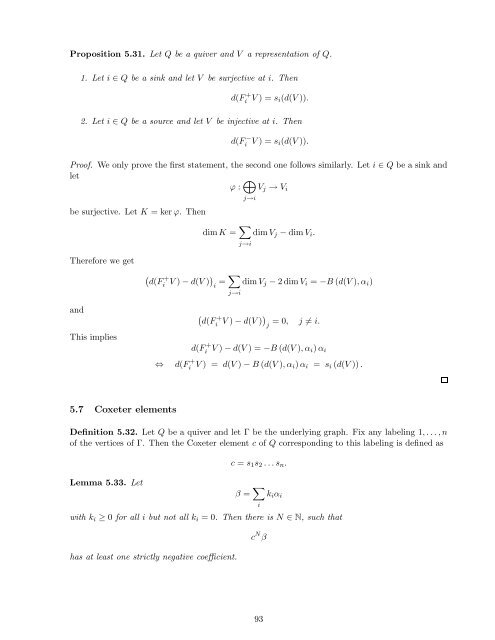Lecture notes for Introduction to Representation Theory
Lecture notes for Introduction to Representation Theory
Lecture notes for Introduction to Representation Theory
Create successful ePaper yourself
Turn your PDF publications into a flip-book with our unique Google optimized e-Paper software.
Proposition 5.31. Let Q be a quiver and V a representation of Q.<br />
1. Let i Q be a sink and let V be surjective at i. Then<br />
d(F i + V ) = s i (d(V )).<br />
2. Let i Q be a source and let V be injective at i. Then<br />
d(F i − V ) = s i (d(V )).<br />
Proof. We only prove the first statement, the second one follows similarly. Let i Q be a sink and<br />
let<br />
: V j ⊃ V i<br />
be surjective. Let K = ker . Then<br />
There<strong>for</strong>e we get<br />
j⊥i<br />
dim K = dim V j − dim V i .<br />
j⊥i<br />
⎩<br />
d(F + V ) − d(V ) = dim V j − 2 dim V i = −B (d(V ), ϕ i )<br />
i<br />
i<br />
j⊥i<br />
and<br />
This implies<br />
⎩<br />
d(Fi + V ) − d(V ) j<br />
= 0, j ⇒ = i.<br />
d(F i + V ) − d(V ) = −B (d(V ), ϕ i ) ϕ i<br />
⊆ d(F + V ) = d(V ) − B (d(V ), ϕ i ) ϕ i = s i (d(V )) .<br />
i<br />
5.7 Coxeter elements<br />
Definition 5.32. Let Q be a quiver and let be the underlying graph. Fix any labeling 1, . . . , n<br />
of the vertices of . Then the Coxeter element c of Q corresponding <strong>to</strong> this labeling is defined as<br />
Lemma 5.33. Let<br />
c = s 1 s 2 . . . s n .<br />
α = k i ϕ i<br />
with k i ⊂ 0 <strong>for</strong> all i but not all k i = 0. Then there is N N, such that<br />
has at least one strictly negative coefficient.<br />
i<br />
N<br />
α c<br />
93

















